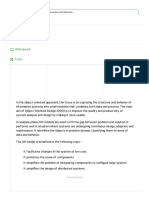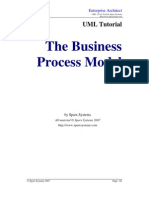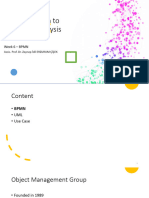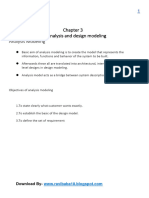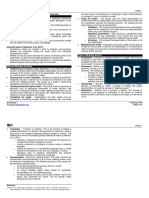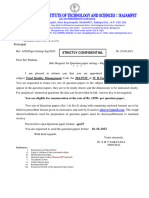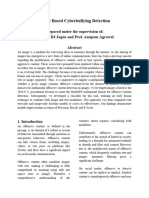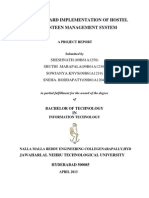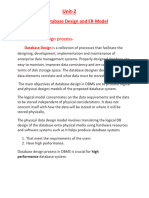Enterprise Architecture Languages
Enterprise Architecture Languages
Uploaded by
First LastCopyright:
Available Formats
Enterprise Architecture Languages
Enterprise Architecture Languages
Uploaded by
First LastCopyright
Available Formats
Share this document
Did you find this document useful?
Is this content inappropriate?
Copyright:
Available Formats
Enterprise Architecture Languages
Enterprise Architecture Languages
Uploaded by
First LastCopyright:
Available Formats
IT1913
Enterprise Architecture Languages o Gateway – A decision point that can adjust the path based on
Business Process Modeling Notation (BPMN) conditions or events. A gateway can be exclusive or inclusive, parallel,
• This was originally developed by the Business Process Management complex, or based on data or event.
Initiative (BPMI). In 2005, the Object Management Group took over the
initiative (Lucid Software Inc., n.d.).
• This is also known as Business Process Model and Notation.
• The goal of BPMN is to support business process modeling by providing
a comprehensive standard notation to business users, while representing
the complex process semantics for technical users. Figure 3. Notation of gateways in BPMN.
• It is intended to be used by stakeholders who design, manage, and realize Source: https://www.lucidchart.com/pages/bpmn
business processes (BP). • Connecting Objects
• It has an easy to use flowchart-like notation that is independent of any o Sequence flow – This shows the order of activities to be performed.
particular implementation environment. o Message flow – This depicts messages that flow across pools, or
• It creates a standardized bridge for the gap between the business process organizational boundaries such as departments. It should not connect
design and process implementation (Object Management Group, n.d.). events or activities within a pool.
• This helps with communication leading to Extensible Markup Language o Association – This associates an artifact or text to an event, activity,
(XML). or a gateway.
Element Types in Business Process Diagrams (Lucid Software Inc., n.d.) • Swimlanes
• Flow Objects o Pool – It represents major participants in a process. A different pool
o Event – A trigger that starts, modifies, or completes a process. Event may be in a different company or department but still involved in the
types include message, timer, error, compensation, signal, cancel, process.
escalation, link, etc. An event can be classified as either "throwing" or o Lane – It is a sub-part of a pool. It shows the activities and flow for a
"catching," depending on their function. certain role or participant, defining the accountability within the
processes.
Figure 1. Notation of events in BPMN.
Source: https://www.lucidchart.com/pages/bpmn
o Activity – A particular task performed by a person or system. It can
include sub-processes, loops, multiple loops, and compensations.
Figure 4. Notation of swimlanes in BPMN.
Source: https://www.lucidchart.com/pages/bpmn
• Artifacts
o Data object – This shows the necessary data for an activity.
Figure 2. Notation of different activities in BPMN. o Group – This shows a logical grouping of activities, but does not
Source: https://www.lucidchart.com/pages/bpmn change the diagram's flow.
03 Handout 1 *Property of STI
student.feedback@sti.edu Page 1 of 3
IT1913
o Annotation – This provides further explanation to a part of the • Object – This concept involves class diagrams, which describes the
diagram. structure of a system in terms of objects, attributes, associations, and
operations.
• Dynamic – This concept involves interaction diagrams, state machine
diagrams, and activity diagrams, which are used to describe internal
behavior of the system.
Types of UML Diagrams (SmartDraw, LLC, n.d.)
• Structural UML Diagrams
o Class diagram – It describes the static structure of a system.
Figure 5. Notation of artifacts in BPMN. o Package diagram – It is a subset of a class diagram used to organize
Source: https://www.lucidchart.com/pages/bpmn
elements of a system into related groups.
Sub-Models Within A BPMN Diagram (Lucid Software Inc., n.d.)
o Object diagram – It describes the static structure of a system at a
• Private BP – This involves internal processes to a specific organization particular time, and can be used to test class diagrams for accuracy.
and do not cross pools or organizational boundaries. o Component diagram – This describes the organization of physical
• Abstract BP – This occurs between a private BP and an external software components, including source codes, run-time code, and
participant or process. This does not show the private BP itself. executables.
• Collaborative BP –This shows the interactions between two or more o Composite structure diagram – This diagram shows the internal
business entities. parts of a class.
o Deployment diagram – This depicts the physical resources in a
Unified Modeling Language (UML) system, including nodes, components, and connections.
• This was created to establish a common, semantic, and syntactical visual • Behavioral UML Diagrams
modeling language for the architecture, design, and implementation of o Activity diagram – This illustrates the dynamic nature of a system by
complex software systems both structurally and behaviorally (Lucid modeling the flow of control from activity to activity.
Software Inc., n.d.). o Communication diagram – This describes the interactions among
• This is currently the most important industry-standard language for classes in terms of an exchange of messages over time.
specifying, visualizing, constructing, and documenting software systems. o Use case diagram – This models the functionalities of a system using
• It emerged from the combination of three (3) existing practices namely, the actors and use cases, and can be considered as a simplified version
Booch Method, Object-Modeling Technique (OMT), and Objectory of a collaboration diagram introduced in UML 2.0.
(Lankhorst, 2017). o State machine diagram – This describes the dynamic behavior of a
• This is commonly used by programmers, but not generally used by system in response to external stimuli.
database developers. o Sequence diagram – It models the interactions between
• The Object Management Group (OMG) oversees the definition and objects in sequence.
maintenance of the UML specifications, which provides engineers and o Interaction overview diagram – It is a combination of an activity and
programmers the ability to use one language for different purposes during a sequence diagram, which models a more complex interaction.
all phases of the software lifecycle, for all system sizes (Lucid Software o Timing diagram – It is an interaction UML diagram that focuses on
Inc., n.d.). processes that take place during a specific period of time, wherein
Modeling Concepts Specified by UML (Lucid Software Inc., n.d.) time is shown to increase from left to right.
• Functional – This concept involves use case diagrams, which describes
system functionality from the point of view of a user. Architecture Description Language (ADL)
03 Handout 1 *Property of STI
student.feedback@sti.edu Page 2 of 3
IT1913
• It is a general term referring to different formal languages used in enabling
formalization, description, specification, modeling and reasoning of
software architectures (Vac, 2017).
• A good ADL must be capable of providing adequate abstractions in
modeling large systems.
• A wide variety of ADLs exist, with several differences in the exact concepts
it offer, and are mainly suitable for users with technical background
(Lankhorst, 2017).
• Some examples of ADLs are UniCon, Wright, and Acme.
Important Properties of ADLs
o Ability to represent components along with property assertions,
interfaces, and implementations
o Ability to represent connectors along with protocols, property
assertions, and implementations
o Component and communication abstraction and encapsulation
o Ability to accommodate analysis tools openly
o Limiting communication to those components connected to each other
architecturally
o Ability to model dynamic architectures
o Ability to reason about causality and time
o Hierarchical refinement support
o Ability to check conformance
References:
Lankhorst, M. et al. (2017). Enterprise Architecture at Work Modeling, Communication and
Analysis (4th ed.). Berlin, Germany: Springer Nature
Lucid Software Inc. (n.d.). What is Business Process Modeling Notation?. Retrieved from
https://www.lucidchart.com/pages/bpmn on December 17, 2019
Lucid Software Inc. (n.d.). What is Unified Modeling Language?. Retrieved from
https://www.lucidchart.com/pages/what-is-UML-unified-modeling-language on December
18, 2019
Object Management Group. (n.d.). Graphical Notations for Business Processes. Retrieved from
https://www.omg.org/bpmn/ on December 17, 2019
SmartDraw, LLC. (n.d.). UML Diagram. Retrieved from https://www.smartdraw.com/uml-
diagram/ on December 18, 2019
Vac, G. (2017). Architecture Description Languages. Today Software Magazine Issue 55.
Retrieved from https://www.todaysoftmag.com/article/2241/architecture-description-
languages on December 19, 2019
03 Handout 1 *Property of STI
student.feedback@sti.edu Page 3 of 3
You might also like
- OOADwebinarDocument44 pagesOOADwebinarkrishkiran2408No ratings yet
- Department of Computer Science & Engineering Object Oriented Analysis and Design Unit-I Uml DiagramsDocument6 pagesDepartment of Computer Science & Engineering Object Oriented Analysis and Design Unit-I Uml Diagramsviswanath kaniNo ratings yet
- Unit 1 OoadDocument104 pagesUnit 1 OoadganeshNo ratings yet
- Object Oriented ApproachDocument12 pagesObject Oriented Approachmrunique7799No ratings yet
- OOAD UML Diagrams NotesDocument104 pagesOOAD UML Diagrams NotesganeshNo ratings yet
- Gomilitary - In: Architectural Blueprints-The "4+1" View Model of Software ArchitectureDocument15 pagesGomilitary - In: Architectural Blueprints-The "4+1" View Model of Software Architecturesiddhartha_maity_4No ratings yet
- Introduction of Rational Rose and UMLDocument27 pagesIntroduction of Rational Rose and UMLchetan1710198286% (7)
- (Coding Big Data) - Week 13 - Business Process Analysis Part 2Document33 pages(Coding Big Data) - Week 13 - Business Process Analysis Part 2danielbayu288No ratings yet
- Business Process Model TutorialDocument10 pagesBusiness Process Model TutorialAlberto Emaj100% (1)
- Object Modeling and C++ Programming For Bca 2nd Semester PDFDocument44 pagesObject Modeling and C++ Programming For Bca 2nd Semester PDFsatyapt007No ratings yet
- Lecture (1) REDocument55 pagesLecture (1) REamjaaad996No ratings yet
- Unit 1 Uml Diagrams: Vel Tech High Tech Dr. Rangarajan Dr. Sakunthala Engineering CollegeDocument79 pagesUnit 1 Uml Diagrams: Vel Tech High Tech Dr. Rangarajan Dr. Sakunthala Engineering CollegevanithaNo ratings yet
- Unit 2 - Software ArchitectureDocument12 pagesUnit 2 - Software ArchitectureLucky KanatheNo ratings yet
- Unit V PDFDocument12 pagesUnit V PDFRoshan ShresthaNo ratings yet
- OOAD Question Bank NotesDocument306 pagesOOAD Question Bank NotesRavindranathNo ratings yet
- Romi BPMN 02 Elements Mar2016Document169 pagesRomi BPMN 02 Elements Mar2016SuperbejoNo ratings yet
- UML DiagramsDocument30 pagesUML Diagramsblazecyclone2020No ratings yet
- Lesson 3 Architecture Documentation and DiagrammingDocument30 pagesLesson 3 Architecture Documentation and Diagramminginoyhana3No ratings yet
- Module6 - Object Oriented Design - UML Diagrams in DesignDocument79 pagesModule6 - Object Oriented Design - UML Diagrams in DesignGerardAlbaNo ratings yet
- Unit IIIDocument29 pagesUnit IIIEsha ChavanNo ratings yet
- RequirementsEng Module6ADocument45 pagesRequirementsEng Module6Atrial.dzulhelmyNo ratings yet
- Using UML Activity Diagrams For The Process View: Ben LiebermanDocument10 pagesUsing UML Activity Diagrams For The Process View: Ben LiebermanmyinmailNo ratings yet
- Ooad Notes Units 2Document40 pagesOoad Notes Units 2richerdworkNo ratings yet
- Arch06 3 2Document28 pagesArch06 3 2raja haseebNo ratings yet
- Department of Computer Science & Engineering Object Oriented Analysis and Design Unit-Ii Design PatternsDocument4 pagesDepartment of Computer Science & Engineering Object Oriented Analysis and Design Unit-Ii Design Patternsviswanath kaniNo ratings yet
- Mod 2Document29 pagesMod 2Ayan DasNo ratings yet
- Slide Set 6 Requirement ModelingDocument30 pagesSlide Set 6 Requirement ModelingKanika ChananaNo ratings yet
- S03 - Requirement Modeling (Use Case Diagram)Document34 pagesS03 - Requirement Modeling (Use Case Diagram)mashNo ratings yet
- Sachin Se FileDocument15 pagesSachin Se Filesachinsingh991127No ratings yet
- Department of Computer Science & Engineering Cs6502-Object Oriented Analysis and Design Unit-Ii Design PatternsDocument4 pagesDepartment of Computer Science & Engineering Cs6502-Object Oriented Analysis and Design Unit-Ii Design PatternsvijiNo ratings yet
- 4 1view-ArchitectureDocument15 pages4 1view-ArchitecturearbisonnkNo ratings yet
- Department of Computer Science & Engineering Object Oriented Analysis and Design Unit IvDocument3 pagesDepartment of Computer Science & Engineering Object Oriented Analysis and Design Unit Ivviswanath kaniNo ratings yet
- Se Unit-3Document10 pagesSe Unit-3pish2922No ratings yet
- Object Oriented Programme Using Java Anju Philip 1Document34 pagesObject Oriented Programme Using Java Anju Philip 1Sneha TiwariNo ratings yet
- Architectural Blueprints - The "4+1" View Model of Software ArchitectureDocument16 pagesArchitectural Blueprints - The "4+1" View Model of Software ArchitectureRonald N Meza CNo ratings yet
- Ooad Unit-6Document29 pagesOoad Unit-6soumya moturiNo ratings yet
- Ooad Unit-6Document29 pagesOoad Unit-6soumya moturiNo ratings yet
- UML Diagrams: Jung WooDocument39 pagesUML Diagrams: Jung WoodarwinabadNo ratings yet
- Object Oriented Analysis and DesignDocument60 pagesObject Oriented Analysis and DesignMatthew Tedunjaiye100% (1)
- SDA Lecture 5 & 6Document55 pagesSDA Lecture 5 & 6ssssNo ratings yet
- OOAD LAB ManualDocument187 pagesOOAD LAB ManualsangeethaNo ratings yet
- Lecture-Design PatternDocument114 pagesLecture-Design PatternIsmail Hossain Naim06132No ratings yet
- 6 HaftaDocument36 pages6 HaftaSemanur ÜnalNo ratings yet
- SE - Lecture 6Document90 pagesSE - Lecture 6Sheharyar LiaqatNo ratings yet
- R16 4-1 Sadp - Unit 1Document21 pagesR16 4-1 Sadp - Unit 1DURGA PRAKASH SENAPATHINo ratings yet
- OOAD Unit 2Document18 pagesOOAD Unit 220CSE312 BHANU PRAKASHNo ratings yet
- Rumbaugh's Object Modelling Technique (OMT) - : Unit Ii Object Oriented Methodologies 9Document71 pagesRumbaugh's Object Modelling Technique (OMT) - : Unit Ii Object Oriented Methodologies 9ASUIUX DesignerNo ratings yet
- Notes Ooad Unit 3Document32 pagesNotes Ooad Unit 3Parmeshwar KumarNo ratings yet
- Online Course Register SystemDocument16 pagesOnline Course Register Systemsuriya extazeeNo ratings yet
- RationalrosenotesDocument26 pagesRationalrosenoteskarthik_manda7923No ratings yet
- Module 4 Software Analysis and DesignDocument14 pagesModule 4 Software Analysis and Designhanif malgundkarNo ratings yet
- OOSE PaPER soLVEDDocument19 pagesOOSE PaPER soLVEDSiddhi SonawaneNo ratings yet
- Department of Computer Science & Engineering Cs6502-Object Oriented Analysis and Design Unit Iv Applying Design PatternsDocument3 pagesDepartment of Computer Science & Engineering Cs6502-Object Oriented Analysis and Design Unit Iv Applying Design PatternsvijiNo ratings yet
- Sencp 3Document38 pagesSencp 3Abhijit BhongNo ratings yet
- Se RecordDocument127 pagesSe RecordMoshika VetrivelNo ratings yet
- Introduction to Reliable and Secure Distributed ProgrammingFrom EverandIntroduction to Reliable and Secure Distributed ProgrammingNo ratings yet
- Introduction To Enterprise ArchitectureDocument2 pagesIntroduction To Enterprise ArchitectureFirst LastNo ratings yet
- Modeling As A Transformation Process: Student - Feedback@sti - EduDocument2 pagesModeling As A Transformation Process: Student - Feedback@sti - EduFirst LastNo ratings yet
- Modeling GuidelinesDocument2 pagesModeling GuidelinesFirst LastNo ratings yet
- Introduction To HTML: Student - Feedback@sti - EduDocument4 pagesIntroduction To HTML: Student - Feedback@sti - EduFirst LastNo ratings yet
- CH 14Document2 pagesCH 14RAJANo ratings yet
- Software Engineering An Overview: Ranjit Raman Team Coordinator E-Gov, C-DAC, PuneDocument37 pagesSoftware Engineering An Overview: Ranjit Raman Team Coordinator E-Gov, C-DAC, PuneShaharukh NadafNo ratings yet
- TQM - QP Setting Request LetterDocument9 pagesTQM - QP Setting Request LetterShashznkNo ratings yet
- Cert and CPMDocument11 pagesCert and CPMECRCNo ratings yet
- User Interaction Design: Information Technology and Information Systems DepartmentDocument23 pagesUser Interaction Design: Information Technology and Information Systems DepartmentArnold Adriel TarregaNo ratings yet
- DAL - Case Study 1Document19 pagesDAL - Case Study 1prathmeshchakre.scoe.mechNo ratings yet
- Image Search Engine Using DeepLearningDocument5 pagesImage Search Engine Using DeepLearningRajesh BathulaNo ratings yet
- BIM Coordination in A NutshellDocument12 pagesBIM Coordination in A Nutshellalanoud-batainehNo ratings yet
- Dynamic Travel Time Prediction ModelsDocument14 pagesDynamic Travel Time Prediction Modelscristian_master100% (1)
- Multi-Objective Product Allocation Model in WarehousesDocument9 pagesMulti-Objective Product Allocation Model in WarehousesleonardommitoNo ratings yet
- Welcome To AI For EveryoneDocument3 pagesWelcome To AI For EveryonebharatNo ratings yet
- FinalDocument25 pagesFinalBalu vemireddyNo ratings yet
- Question BankDocument16 pagesQuestion BankrishikarthickNo ratings yet
- Industrial Control Systems - 01 IntroductionDocument5 pagesIndustrial Control Systems - 01 IntroductionBehzad SamadiNo ratings yet
- PDF Radial Basis Function RBF Neural Network Control For Mechanical Systems - CompressDocument15 pagesPDF Radial Basis Function RBF Neural Network Control For Mechanical Systems - CompressLêNhậtMinhNo ratings yet
- IVP ReportDocument12 pagesIVP Reportsunnyy53059155No ratings yet
- Total Quality Management and Six SigmaDocument306 pagesTotal Quality Management and Six SigmaSohabe MalikNo ratings yet
- D3 - FTA Calc Numbers Main BodyDocument2 pagesD3 - FTA Calc Numbers Main BodyAmaury FreireNo ratings yet
- Rfid Cash Card Implementation of Hostel and Canteen Management SystemDocument7 pagesRfid Cash Card Implementation of Hostel and Canteen Management SystemShruthi ReddyNo ratings yet
- Free and Open Machine LearningDocument143 pagesFree and Open Machine LearningAli JameelNo ratings yet
- Networks Traffic TheoryDocument13 pagesNetworks Traffic Theoryzco bilalNo ratings yet
- Multivariable Feedback Control 2005Document293 pagesMultivariable Feedback Control 2005NazarRozkvas100% (3)
- Unit-2 DBMS NotesDocument51 pagesUnit-2 DBMS NotesAmrith MadhiraNo ratings yet
- Recommendation SystemDocument19 pagesRecommendation SystemMufaddal ChallahwalaNo ratings yet
- Ramias, Rummler (2009)Document8 pagesRamias, Rummler (2009)helenaschmidt003No ratings yet
- Documentation Chapter1 3Document13 pagesDocumentation Chapter1 3JoanaNo ratings yet
- Characteristics of Good Management ControlDocument2 pagesCharacteristics of Good Management ControlSHeena MaRie ErAsmo100% (1)
- DBMS Unit-1Document38 pagesDBMS Unit-1prabandha puttiNo ratings yet
- Software Requirements Specification Document For Urban ClapDocument26 pagesSoftware Requirements Specification Document For Urban ClapGajendra PandeyNo ratings yet
- Control of Multiple-Input, Multiple-Output ProcessesDocument38 pagesControl of Multiple-Input, Multiple-Output ProcessesdhineshpNo ratings yet



